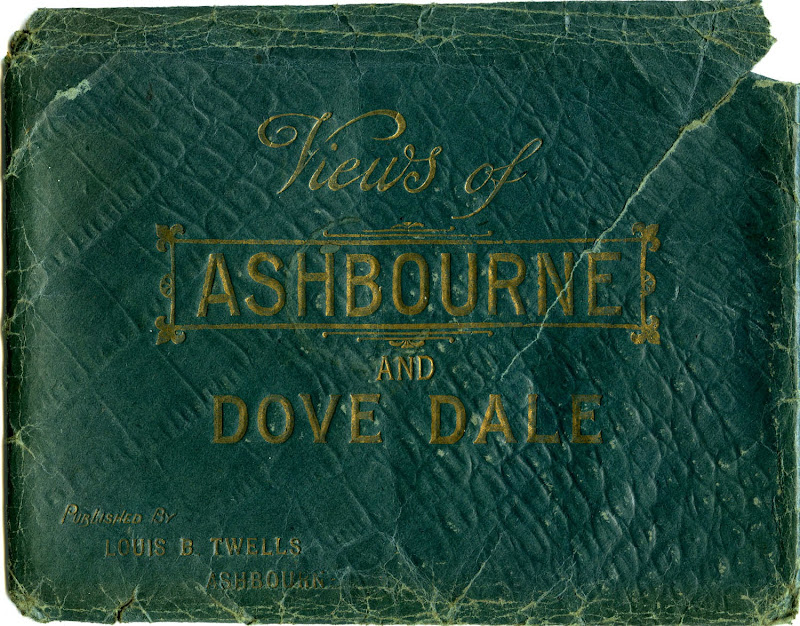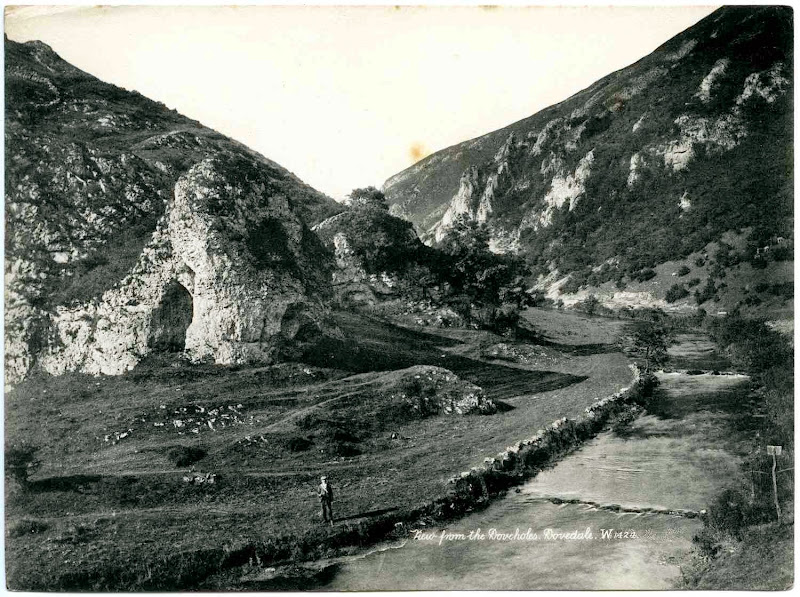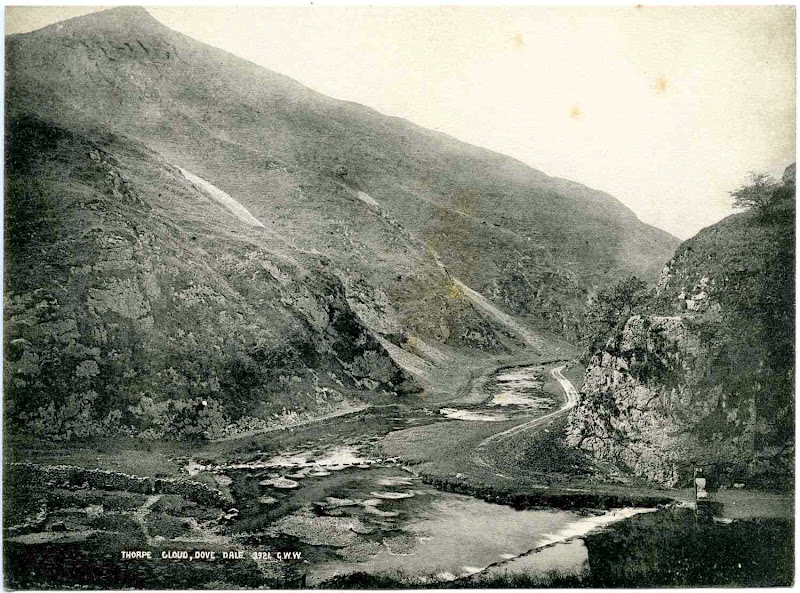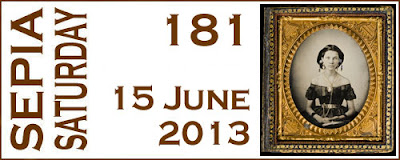
This week's Sepia Saturday photo of a group of intrepid adventurers posing at the entrance to a limestone cave system in New South Wales gives me an opportunity to make a return visit to Dovedale in the English Peak District, which I have featured a couple of years ago: Donkey Rides at Dovedale and The Compleat Angler, a Derbyshire Fishing Trip.

Views of Ashbourne and Dove Dale
Published by Louis B. Twells, Ashbourne
This time I can use a couple of more recent acquisitions, purchased for very modest sums on eBay. The first, a large envelope made of green paper with a shiny, faux crocodile skin finish and gold print, contains 32 black-and-white and blue-tinted lithographic prints, each measuring approximately 205 x 151mm (8" x 6"). The title on the envelope simply states, "Views of Ashbourne and Dove Dale" - which indeed they are - published by Louis B. Twells of Ashbourne.
Louis Bosworth Twells (1829-1885) settled in Ashbourne (Derbyshire) around 1855, and over the next three decades conducted a variety of trades: hair cutter/dresser, perfumer, jeweller, silversmith, watch maker, importer of general fancy goods, sponges, &c., and proprietor of "large show rooms for glass, china, and earthenware." I have seen a single example of a carte de visite portrait which he also "published." There is no direct evidence that he took any photographs himself, but he may well have done. After his death in 1885 his widow and son, also named Louis B. Twells, continued to operate the business until 1903.

View from the Doveholes, Dovedale (Ref. W. 1424)
Original photograph publ. by James Valentine & Co.
Lithographic print publ. by Louis B. Twells, Ashbourne
This view of Dovedale from the mouth of the limestone cave known as Dove Holes is one of 16 prints of excellent quality which don't carry the name of either photographer or publisher. A detailed examination of the prints reveals artefacts suggesting that they were reproduced from carefully retouched photographic prints.

After some deliberation I've decided that the text so carefully pencilled out in this image included a negative number and the original publisher's initials:
1424 JV + Co. Ltdin the characteristic cursive script used by famous postcard publisher James Valentine & Co. of Dundee. However, I've yet to find an example of the original photograph published by Valentine.

Thorpe Cloud, Dovedale (Ref. 3921)
Original photograph publ. by George Washington Wilson
A second group of 16 prints show similar landscapes. Although of slightly poorer reproduction quality, these views are still very professionally composed, and are annotated with the initials "G.W.W." This indicates that they were originally published by George Washington Wilson & Co. of Aberdeen, another Scottish photographer who became one of the largest publishers of photographic prints in the world, rivalling the business of Valentine and Sons.

In Dovedale Looking Up Entrance to Dale, (Ref. 3923)
Glass plate negative 220 x 170mm by G.W. Wilson & Co. of Aberdeen
Image © and courtesy of University of Aberdeen Library, Special Collections and Museums
The University of Aberdeen Library has an enormous collection of 45,000 of George Washington Wilson's glass plate negatives, the original photographs taken between 1853 and 1908, with digitized images online. There are 488 views of Derbyshire alone and the web site is well worth a visit. I wasn't able to find the same view, but I did find a similar one, with a negative number (3923) suggesting that it was probably taken on the same occasion.
Views of Ashbourne and Dovedale
Images © and collection of Brett Payne
The remaining views from the Ashbourne & Dovedale collection can be seen in this slideshow created with Picasa. It's difficult to know now if all 32 of the prints were originally sold in this wallet, or whether the G.W. Wilson prints were added later by a previous owner. However, from what I can tell, they appear to have been taken over roughly a decade from the mid-1880s through to the mid-1890s. Photographs mounted on glossy card of the particular shade of dark green used for the envelope were very popular in the 1890s, and I suspect that Louis Twells Junior was selling this collection at this time.

Unidentified group at Twelve Apostles' Rock, Dovedale, c.1900-1910
Lantern slide (83 x 83mm) by unknown photographer
Images © and collection of Brett Payne
My other purchase was a small group of lantern slides, almost certainly taken by an amateur, two of which depict an outdoor excursion by a small group of young men and women. Although not annotated, the view above is identifiable as the River Dove in the vicinity of Twelve Apostles' Rock, also shown in one of the prints by G.W. Wilson in the slideshow above.

Unidentified group, probably at Dovedale, c.1900-1910
Lantern slide (83 x 83mm) by unknown photographer
Images © and collection of Brett Payne
A second image shows three men and four women seated on a hillside, judging by the nature of the scree, probably the lower slopes of Thorpe Cloud or one of the adjacent hills flanking the entrance to Dovedale. If, as seems likely, the group consisted of four young couples, a fourth man is probably taking the photograph. One of the other slides in this small collection is dated 1906, and the clothing fashions of the women in the photo suggest that these are from a similar time period.

Magic Lantern Projector
Image © and courtesy of the Tauranga Heritage Collection
The second half of the nineteenth century saw a huge expansion in the number of people taking trips to the seaside and day excursions into the country. Pictorial mementos available to the everyday tourist included scenic images in the form of stereoscopic cards, carte de visites and unmounted prints published by both local firms and by larger enterprises such as Valentines and G.W. Wilson.
During the 1890s and early twentieth century advances in camera design and technology made them considerably cheaper and more portable. As a result, excursionists were able to create their own mementos as they enjoyed their holiday. These lantern slides were most likely produced by direct printing on thin glass slides from original glass-plate negatives, and would have been displayed with a magic lantern projector similar to that shown above.
References
Postcard Publishers, Printers, and Distributors of Note by the Metropolitan Postcard Club of New York City.
The George Washington Wilson and Co. Photographic Collection, University of Aberdeen Photographic Archive.
George Washington Wilson Collection online.
























































 Criss-crossing the Atlantic regularly allowed them to stop off periodically in
Criss-crossing the Atlantic regularly allowed them to stop off periodically in 

